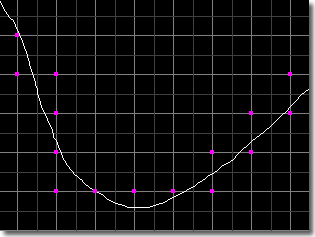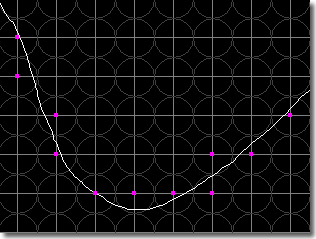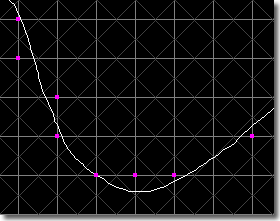Freeman Chain Code链码
来源:互联网 发布:石家庄鸿搜网络怎么样 编辑:程序博客网 时间:2024/04/27 07:05
The Basics of Chain Coding
A line drawing is an image of line or curve segments that may be connected or disconnected. Several applications require the storage of line drawings in computer graphics, image processing, pattern recognition and even Automated Cartography in Geographic Information Systems where contours of maps have to be stored.
Freeman et al. proposed several methods called Chain Coding to represent line drawings that help efficient transmission and storage of such data. For this purpose it is required to quantize and encode the 2D figure. A uniform mesh is superimposed on the line drawing. We assume that the distance between two consecutive mesh nodes is T. A line drawing is quantized or approximated using curve points. Curve points are chosen to represent points on the line drawing by specifying mesh nodes that are close to the curve in terms of the different quantization schemes, giving different representations for each scheme. Three such quantization methods are described below.
Quantization Schemes
Square Quantization
Each mesh node is taken to be the center of a square of side T as shown in the figure below. When some part of the line drawing or curve falls within the square, of a particular mesh node, that node is marked as a curve point. In the example of the curve given in the figure, this quantization scheme gives rise to the pattern with curve points shown in magenta.
Circular Quantization
The same idea as above is applied in this quantization scheme except that each mesh node is considered to be the center of a cricle of radius T/2 as shown in the figure below. When some part of the line drawing falls within the circle, of which a mesh node is the center, that node is considered a curve point. This method gives rise to the sequence of curve points shown again in magenta in the figure below.
Grid-Intersect Quantization
In this scheme curve points are selected according to where the curve intersects the mesh lines between adjacent nodes. Each place the line drawing intersects the mesh, the mesh nodes associated with the mesh line are considered. The node which is closer to the intersection is selected as a curve point. When there is more than one intersection point around the mesh node, only one curve point is chosen. The sequence of magenta dots arises from this process as shown in the figure below.
The approximation of a line drawing using the sequence of curve points found using any of the three quantization schemes described above can be coded using at most 8 bits per line segment. This is because for any curve point the next curve point in the sequence can be in at most eight directions as shown in the figure below.
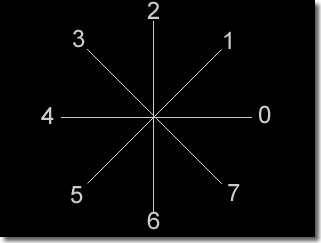
Each line segment in the approximation is given a code according to the eight directions the segment can take, giving rise to a chain code representation for each line drawing. Each of the three quantization schemes desribed yield the chain codes shown in the next figure.
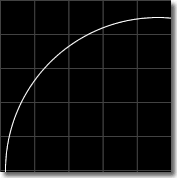
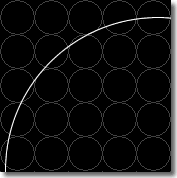
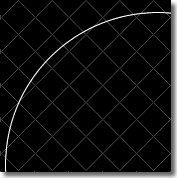
Freeman Code 22020200
Freeman Code 221010
Freeman Code 221100
The different quantization schemes often yield very different chain codes for the same line drawing. One of the factors in which the schemes differ is the number of diagonal line segments they contain. It can be readily seen that the square quantization does not give any diagonal segments (assuming that the line drawing never passes through the intersection of two mesh lines), whereas they do occur in circular and grid-intersect quantizations. According to Freeman, diagonal elements should occur half the time for random configurations for a good or close approximation.
The Minkowski Metric
The k-Minkowski metric between two points p=(x1,y1) and q=(x2,y2) can be given as

where k >= 1.
For k=2, this becomes,

which is the Euclidean distance between the two points.
For k=∞, this becomes

The figure below shows the locus of points around a mesh node by taking dk (p,q)=![]() for k=1,2 and ∞. For k=∞, the locus is a square of side T. For k=2, it is a circle of radius
for k=1,2 and ∞. For k=∞, the locus is a square of side T. For k=2, it is a circle of radius ![]() and for k=1, it is a rhombus of diagonal T and side
and for k=1, it is a rhombus of diagonal T and side ![]() .
.
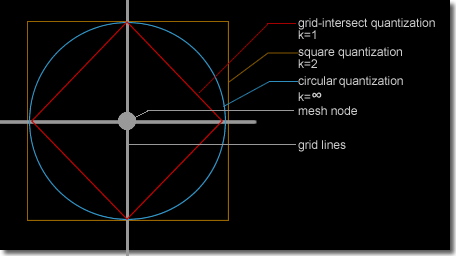
If L denotes the set of points in the line drawing, then we can give a more formal definition of a curve point using the Minkowski metric.
Definition: For a line drawing L and a mesh gap T, a mesh node is a curve point, according to the k-Minkowski metric quantization, if and only if the distance from the node to the closest point in the set L is less than ![]() .
.
If k=∞, the quantization scheme becomes the square quantization and for k=2, it becomes the circular quantization scheme. For k=1, a new quantization scheme arises called the rhombic quantization. Convex quantizations can be referred to as all schemes where the region checked around the mesh node is convex.
The Freeman Chain Coding Applet
Drag your mouse anywhere in the black canvas to draw a line or curve segment. Draw slowly, or else (depending on you system), the Java VM might miss points where the mouse is dragged. Use the the slider to adjust the grid resolution. Use the check boxes to toggle the visibility of the grids, cells or the curve itself. The square, circular and grid quantization methods have been implemented. Click on the mesh points button to chose the quantization type from the drop down combo box. Press clear to erase everything and start from scratch. Oh and this is a Java2 applet (JApplet), hopefully you have the Java 2 Plugin from Sun installed.
Applet tested to work in Opera, Mozilla, FireFox (Firebird, Phoenix or whatever name it had before) and Internet Explorer. Icons have been taken from art.gnome.org(GNOME rocks!).Suggestions are welcome . Mail me at jsatta_at_cs_dot_mcgill_dot_ca.
Click here for the (zipped) applet source.
References
- J. Koplowitz and G. T. Toussaint, "A Unified Theory of Coding Schemes for the Efficient Transmission of Line Drawings", Proceedings of IEEE Conference on Communications and Power, Montreal, October 1976, pp. 205-208.
- H. Freeman, "On the Encoding of Arbitrary Geometric Configurations," IRE Trans. Electronic Computers, Vol. EC-10, pp. 260-268, June 1961.
from: http://www.cs.mcgill.ca/~jsatta/pr644/freeman/aboutp.html
- Freeman Chain Code链码
- freeman链码
- freeman 链码
- Freeman链码
- Freeman链码
- freeman链码
- freeman链码
- Chain Code
- opencv cvFindContour 轮廓 freeman链码
- python 下提取图像的Freeman链码
- chain code 编程
- Freeman链码,差分码,归一化链码,归一化差分码
- Freeman链码差分
- [Code Jam] Snapper Chain ---常规算法
- [Code Jam] Snapper Chain ---高效算法
- Chain
- Chain
- About the Freeman MBA Blog
- mapdb 开源包踩坑小记
- 2015年总结
- SQL Server索引的维护 - 索引碎片、填充因子
- Task4
- LCS最长公共子序列入门题
- Freeman Chain Code链码
- 引用 所有的不开心都是要付费的
- Java使用MyEclipse构建webService简单案例
- DiscreteSeekBar使用简介,一个带气泡的SeekBar
- delphi多线程释放
- asp.net中获取Layer弹出层返回值
- 安卓中Intent
- 使用ExpandableListView实现一个时光轴
- 算法面试题整理
